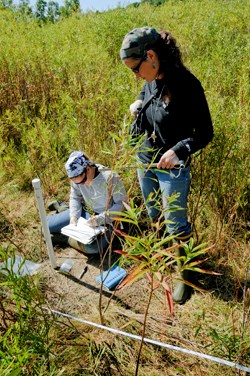
NPS / Ted Toth Wetland MonitoringThe National Park Service has documented over 1,500 wetlands at Cuyahoga Valley National Park. Non-native invasive plant species and pollution are major management issues for the park's wetlands. Wetlands provide numerous ecological services and are important sites of biodiversity, providing habitat for nearly half of all endangered species. As natural floodwater storage sites, wetlands store and assimilate nutrients and reduce stream erosion and stormwater-caused flooding. Unfortunately, over half of the wetlands in the United States have been destroyed over the past two centuries. Roughly 90% of wetlands in Ohio have been eliminated. Human disturbances and invasive plants can alter natural wetland functions. Hydrological changes, such as increased stormwater from upstream development or dewatering by drainage ditches and tiles, affect wetland water quality and quantity and often increase pollutant levels. Wetland size, hydrology, and biological composition may change as a result. Disturbances near or within wetlands create susceptibility to the colonization of invasive plant species, which often dominate plant communities. Heartland Inventory & Monitoring scientists have developed a long term monitoring protocol to document the condition of a subset of wetlands within the park and to track changes in their quality over time. The protocol also includes a watershed-level analysis to evaluate how land use affects wetland condition in specific watersheds. The monitoring data are designed to support park wetland management decisions and restoration efforts. |
Last updated: October 11, 2023
